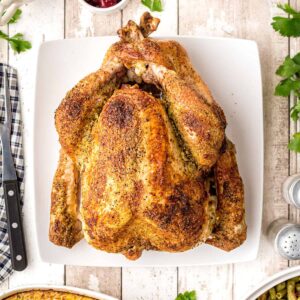Oven Roasted Turkey with Gravy
A simple method for cooking a beautifully moist Oven Roasted Turkey with golden, crispy skin and instructions for making the best pan gravy.

Servings 6 servings
Ingredients
For the Turkey:
- 1 cup butter softened
- 2 tablespoons seasoned salt recommended: Jane's Crazy Mixed-Up Salt
- 10 pounds turkey fresh or frozen
For the Gravy:
- ½ cup pan drippings from turkey
- ½ cup all-purpose flour
- 3 ¾ cups turkey or chicken broth or stock
Instructions
To Roast the Turkey:
- If using a frozen turkey, thaw in the refrigerator allowing at least 24 hours for every 4 pounds of turkey.
- Approximately 1 1/2 hours before cooking, remove the turkey from the refrigerator and let it sit at room temperature.
- Preheat the oven to 325 degrees. Drain any juices from the turkey and pat it dry with paper towels.
- Place the turkey breast side up on a rack in a roasting pan.
- Tuck the wings under the turkey and secure the legs with kitchen twine if needed.
- Rub the turkey generously with the butter. Sprinkle evenly with seasoned salt.
- Place the turkey in the preheated oven.
- About 2/3 through cooking time, check to make sure the breast and tops of the legs aren't browning too quickly. If needed, cover the turkey loosely with a tent of aluminum foil to prevent overcooking.
- Turkey is done when the temperature in the thigh registers 180 degrees on a meat thermometer.
- Remove from the oven and let stand for at least 20 minutes before carving.
To Make the Gravy:
- Remove drippings from the turkey roasting pan and place in a medium saucepan.
- Using a whisk, blend the flour into the pandrippings.
- Whisk in the stock or broth a little at a time
- Place the saucepan over medium high heat and bring to a boil. Reduce the heat to low and simmer for about 5 minutes.
Notes
The times, servings, and nutrition information are calculated based on a 10-pound fresh, unfrozen turkey.
When purchasing your turkey, allow 1 to 1 1/2 pounds per person. More if you'd like lots of leftovers.
Turkey Roasting Time Table:
Times stated are approximate. Use a meat thermometer to determine when your turkey is done correctly.
Tips:
| 6 - 7 pounds | 2 - 2 1/2 hours |
| 7 - 10 pounds | 2 1/2 - 3 hours |
| 10 - 18 pounds | 3 - 3 1/2 hours |
| 18 - 22 pounds | 3 1/2 - 4 hours |
| 22 -24 pounds | 4 - 4 1/2 hours |
| 24 - 30 pounds | 4 1/2 - 5 hours |
- If you don't have a roasting rack, form a coil of aluminum foil to place in the bottom of your pan or use a bed of vegetables such as carrots and celery to keep the turkey raised off the bottom of the pan.
- Skip the basting - basting a turkey means frequently opening the oven door which results in temperature fluctuations that can result in a dry finished bird. The butter rubbed all over will keep the turkey moist without the need for basting.
Nutrition
Serving: 1 | Calories: 1198kcal | Carbohydrates: 13g | Protein: 121g | Fat: 72g | Saturated Fat: 35g | Cholesterol: 472mg | Sodium: 3408mg | Potassium: 1378mg | Fiber: 1g | Sugar: 3g | Vitamin A: 1246IU | Vitamin C: 1mg | Calcium: 73mg | Iron: 5mg